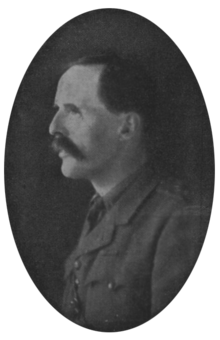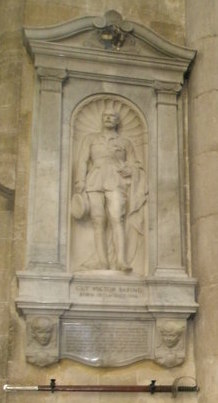| This article needs additional citations for verification. Please help improve this article by adding citations to reliable sources. Unsourced material may be challenged and removed. Find sources: "Guy Baring" – news · newspapers · books · scholar · JSTOR (May 2020) (Learn how and when to remove this message) |

Guy Victor Baring (26 February 1873 – 15 September 1916) was a British Army officer and politician. He became a Conservative member of the British House of Commons but was one of 22 Members killed in action in the First World War.
Background
Baring was a member of the Baring family of Barings Bank, a younger son of Alexander Baring, 4th Baron Ashburton (1835–1889), and his wife Leonora Caroline Digby. He was educated at Eton and the Royal Military College, Sandhurst, and was commissioned into the Coldstream Guards in 1893.
In 1899 Baring's unit was sent to fight in the South African War, and he was present at the battles of Belmont, Graspan, Modder River, Magersfontein, and Driefontein, as well as the occupation of Bloemfontein. During the fighting in South Africa he was mentioned in despatches, and received the Queen's South Africa Medal with three clasps.
Baring was the commander of a detachment of the Coldstream Guards in 1900 which went with the Australia and New Zealand Imperial Representative Corps to the inauguration of The Earl of Hopetoun as Governor-General of Australia. He was promoted to captain in March 1901, attached to the King's African Rifles and was a special service officer with the Jubaland Expedition in 1901 against the Ogaden Somalis and was awarded a medal with clasp.
In February 1902 he was gazetted as a Captain in the Coldstream Guards vice John Ponsonby, who had been seconded to serve in South Africa.
Career
He was elected as the Member of Parliament for Winchester in the 1906 general election, and was re-elected in the January and December 1910 elections with increased majorities.
Although he had formally left the Coldstream Guards in 1913, he rejoined immediately on the outbreak of war in 1914. He was posted to Windsor where he commanded a training company, until July 1915 when he was posted to France. He served as second-in-command of the 4th (Pioneer) Battalion; and after the Battle of Loos he commanded the first Battalion of the Coldstream Guards.
Death

During the Battle of the Somme on the morning of 15 September 1916, Baring's Battalion was advancing along the Ginchy-Lesboeufs road to attack German positions, together with two others. It was the first time in history that three Coldstream Guard battalions attacked together, but despite advancing "as steadily as though they were walking down the Mall" the action took a heavy toll. 17 officers and 690 other ranks went into battle, but only three officers survived (one injured) and 221 other ranks. Baring was buried in Citadel New Military Cemetery near Fricourt. Baring is commemorated on Panel 8 of the Parliamentary War Memorial in Westminster Hall, one of 22 MPs who died during World War I to be named on that memorial. He is also one of 19 MPs who fell in the war who are commemorated by heraldic shields in the Commons Chamber. A further act of commemoration came with the unveiling in 1932 of a manuscript-style illuminated book of remembrance for the House of Commons, which includes a short biographical account of the life and death of Baring.
Family
Baring married on 16 July 1903 Olive Alethea Smith, daughter of Hugh Colin Smith and Constance Maria Josepha Adeane, and they had six children, including the cricketer Giles Baring. Their great grandchildren include the actress Rachel Ward and the actress and environmentalist Tracy Worcester.
References
- "No. 27326". The London Gazette. 25 June 1901. p. 4250.
- "No. 27413". The London Gazette. 4 March 1902. p. 1538.
- "Casualty Details: Baring, The Hon. Guy Victor". Commonwealth War Graves Commission. Retrieved 30 August 2016.
- "Recording Angel memorial Panel 8". Recording Angel memorial, Westminster Hall. UK Parliament (www.parliament.uk). Retrieved 31 August 2016.
- "List of names on the Recording Angel memorial, Westminster Hall" (PDF). Recording Angel memorial, Westminster Hall. UK Parliament (www.parliament.uk). Retrieved 31 August 2016.
- "Baring". Heraldic shields to MPs, First World War. UK Parliament (www.parliament.uk). Retrieved 31 August 2016.
- "House of Commons War Memorial: Final Volumes Unveiled by The Speaker". The Times. No. 46050. London. 6 February 1932. p. 7.
- Moss-Blundell, Edward Whitaker, ed. (1931). The House of Commons Book of Remembrance 1914–1918. E. Mathews & Marrot.
- Burke's Peerage and Baronetage, 106th edition (1999), volume 1, page 120
- Edward Whitaker Moss-Blundell, "The House of Commons Book of Remembrance 1914-1918" (Elkin Mathews & Marrot, 1931)
External links
- Hansard 1803–2005: contributions in Parliament by Guy Baring
| Parliament of the United Kingdom | ||
|---|---|---|
| Preceded byWilliam Myers | Member of Parliament for Winchester 1906–1916 |
Succeeded byDouglas Carnegie |
- 1873 births
- 1916 deaths
- Conservative Party (UK) MPs for English constituencies
- UK MPs 1906–1910
- UK MPs 1910
- UK MPs 1910–1918
- Coldstream Guards officers
- British Army personnel of the Second Boer War
- British Army personnel of World War I
- British military personnel killed in the Battle of the Somme
- British MPs who died in office
- King's African Rifles officers
- Younger sons of barons
- Baring family
- Graduates of the Royal Military College, Sandhurst
- People educated at Eton College